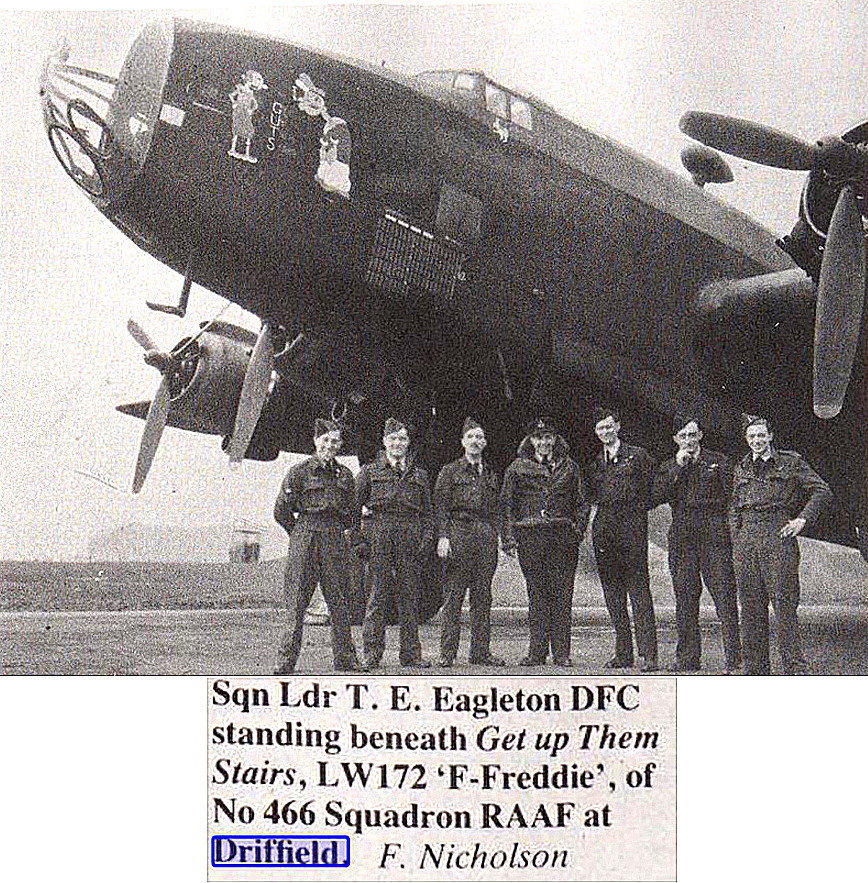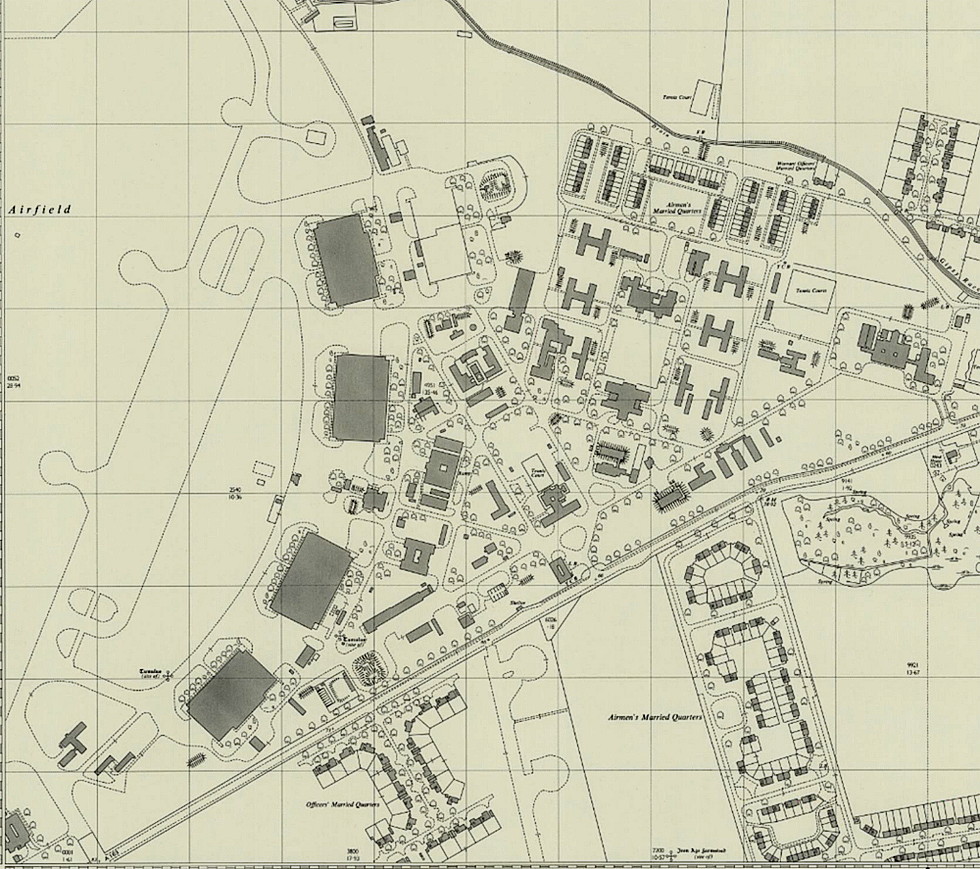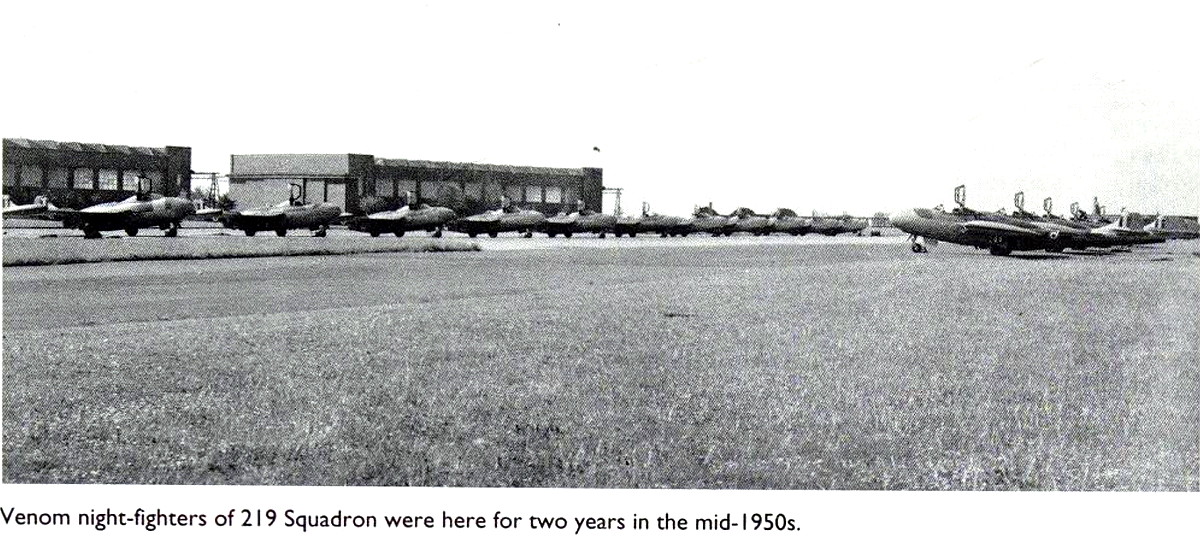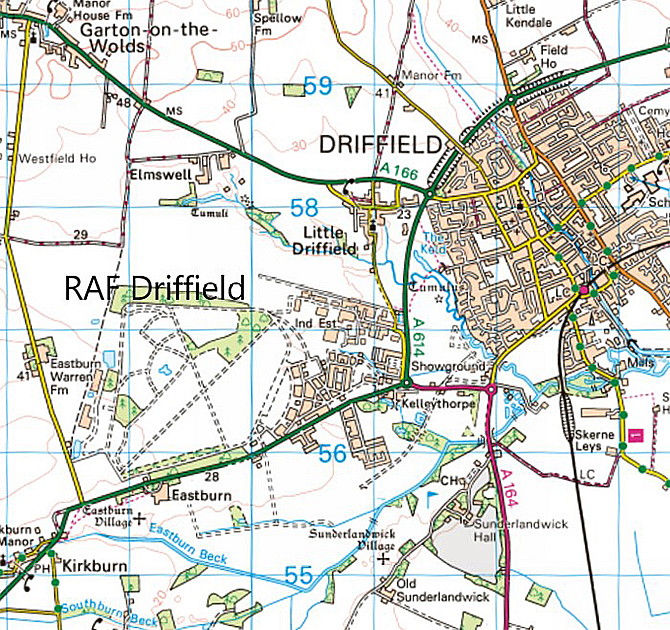Driffield
DRIFFIELD see also EASTBURN and EASTBURN FARM
DRIFFIELD see also GREAT DRIFFIELD 1913 and GREAT DRIFFIELD 1929
DRIFFIELD: Military aerodrome (aka EASTBURN?)
Note: These two pictures were obtained from Google Earth ©
Note: Pictures by the author.
Military users: WW1: RFC/RAF (Royal Flying Corps / Royal Air Force) Landing Ground
33 [Home Defence] Sqdn (1916) (Royal Aircraft Factory B.E.2 and later F.E.2)
RFC/RAF Flying School and Training Depot Station (1917 to 1920)
Inter-war years: Bomber Command
77 & 102 Sqdns (Armstrong Whitworth Whitleys)
WW2: RAF Bomber Command 2 Group 4 Group
88 Sqdn (Fairey Battles)
102 Sqdn (Armstrong-Whitworth Whitleys)
104, 196 & 405 (RCAF) Sqdns (Vickers Wellingtons)
107 Sqdn (Bristol Blenheims)
462 & 466 (RAAF) Sqdns (Handley Page Halifaxs)
Post 1945: RAF Flying Training Command 21 Group
203 AFS (Gloster Meteors & DH Vampires)
204 AFS
RAF Fighter Command
33 Sqdn (DH Venom NF.2s)
Location: 2nm WSW of Great Driffield
Period of operation: 1916 to 1920 then 1936 to 1977
Site area: WW1: 240 acres 1097 x 960
Runways: WW2: 05/23 1829x46 hard 10/28 1280x46 hard
15/33 1280x46 hard
NOTES: The reason I mention 88 Sqdn being here is that their stay was rather temporary and this was so often the case for many RAF and indeed Fleet Air Arm squadrons, who suffered being shuffled around from pillar to post throughout WW2.
In doing this research certain patterns emerge and it seems that 36 hardstandings at most RAF WW2 bomber bases during WW2 appears to be the norm, but why 36? The reason was that a typical RAF squadron of both Bomber and Fighter Command comprised three flights, (A, B & C Flights), each of twelve aircraft. I imagine different structures applied in the Coastal, Training and Transport Commands?
THE HALIFAX
The Handley Page Halifax was the second four-engine bomber type to enter service with the RAF in WW2, the first being the Short Stirling and the third the Avro Lancaster - developed from the ill-fated twin-engine Avro Manchester. It appears that the first operational Halifax's were based here. But, were they flown by 462 and 466 (RAAF) Squadrons?
LEONARD CHESHIRE VC, OM, DSO & Two Bars, DFC
It was here in June 1940 that Pilot Officer Geoffrey Leonard Cheshire flew his first operation as second pilot in a Whitley to bomb a target in northern France. Quite why the RAF Bomber Command senior officers thought that flying their bombers in such small formations from as far away as Yorkshire to bomb a target in northern France was a good idea in 1940 will, I suppose, remain a mystery.
This situation didn’t much improve until early 1943. By then the introduction of ever better technical equipment certainly helped but the facts do seem to indicate that generally those crews in Bomber Command were mostly fighting a war of attrition not too dissimilar from WW1 trench warfare. On the basis that if you throw just more than enough bodies required at the enemy, it follows they’ll get through. I have made comments on the bombing campaign in the listings for other airfields in this region, so there is no need to repeat them here.
Except to say that we must remember that the huge advances made in trying to understand the ‘human condition’ we have today simply didn’t exist then. Nor did concepts such as ‘efficiency’ or ‘overall effectiveness’ and ‘damage limitation’ exist. In fact the general military mentality of regarding a major war still appears to have rested mostly in the WW1 experience.
And why not? It was only about twenty years later on when WW2 was declared! Needless to say, for most of the senior staff in the RAF their air combat experience was learnt
Leonard Cheshire was of course later to become known as a very famous Bomber Command figure and after the war established the ‘Cheshire Homes’ for the disabled.
A MICHAEL T HOLDER GALLERY
We have Mike Holder, now a great friend of this 'Guide', to thank for providing the following, sent some time later after he posted the 'Comment' below.
WORLD WAR 1
The WW1 site map was obtained from the Airfield Research Group. The photo and narrative are from the Driffield Facebook.
BETWEEN THE WARS
The photo of the control tower in the 1930s and the 102 Squadron Armstrong Whitworth Whitley Mk.5s, (below) were obtained from Driffield Facebook.
The Armstrong Whitworth A.W.38 Whitley, (ordered off the 'drawing board'), first flew on the 17th March 1936 from the main factory airfield at WHITLEY ABBEY, after which the type was named. (Note: Not BAGINTON as is often reported). Some 1,815 were built and although obsolete at the start of WW2, it continued to have a varied career in the RAF until it was finally retired from service in 1945.
Initially, as well as night bombing, (it is claimed that they took part in the first bombing raid of WW2, which is doubtful?), it was employed in leaflet dropping sorties. Later as a glider tug for example during the D-Day landings, and, it also served with Coastal Command. One aspect that I only recently found out about in 2024, was that it is reported that BOAC, (British Overseas Airways Corporation), operated fifteen Mk.5 Whitleys, converted to freighters and flying at night, from Gibraltar to Cyprus in 1942.
THE WW2 PERIOD, MAINLY THE HALIFAX ERA HERE AT DRIFFIELD
Notes: In modern times it is probable that, especially going to air shows, that most people can get the impression that during WW2 it was the Avro Lancaster that was the main RAF heavy bomber. If so, this really is a great shame. The Handley Page Halifax was, in many ways as good if not better, despite having its first flight on the 25th October 1939, whereas the Avro Lancaster first flew on the 9th January 1941.
Trying to make direct comparisons is difficult if not impossible, but, a general picture seems to emerge, not least because production numbers appear roughly similar: 6,178 for the Halifax, 7,377 for the Lancaster. It appears the Halifax could carry a heavier bomb load and had a similar ceiling limit, albiet being a tad faster. It was also reputed to be much easier to get out of if fatally attacked. The main advantage for the RAF being that the Halifax had a range of around 1,200 miles whereas the Lancaster could achieve more like 2,500 miles. And that of course, as the war progressed towards its finish, made the Lancaster the main bomber preferred.
Photo One is of a 462 Squadron Halifax landing back, and Photo Two is of Halifax MZ296 with a seperate caption. All three are from Halifax at War by Brian Rapier.
Photo Three shows the crew celebrating after a raid on Berlin and Photo Five shows Sqdn. Ldr. Eagleton and crew: Both also from Halifax at War.
Photo Four, of Halifax operations, is from Military Airfields of Britain, Northern England, by Ken Delv.
LUFTWAFFE BOMBING RAIDS ON RAF AIRFIELDS
The damaged Whitley Mk.5 followed a raid on the 13th March 1941. The four items in this section are all from Bomber Command, 1939 to 1945 by R J Overy. It is perhaps not so widely known, that after the so called 'Battle of Britain', after which the Luftwaffe mainly resorted to the 'Blitz' regime night raids on so many cities, they also kept up raids on RAF aerodromes, sometimes using just one bomber with a very proficent 'crack crew'.
These were often, if not usually, very effective. And in ways they might not have anticipated? For example my father was being trained as a flight engineer on Vickers Wellesley light bombers way out on the west coast of Wales. Up till then the locals had been friendly and cooperative, until a Luftwaffe bomber attacked the aerodrome killing a local on guard duties.
That changed everything. Seems like they thought that this war did not involve the Welsh, or certainly not in this area. From then on the RAF were the enemy. When two Wellesleys collided head on during a training exercise, and the RAF team were sent out to recover the bodies, the local farmer was shooting at them with a shotgun. So much for us being an "United" Kingdom.
The picture of HX266 and Halifax's being serviced are both from Halifax at War by Brian Rapier. A very good 'bitsa', cobbled together full sized 'replica' of a Halifax can be seen in the excellent museum at the Yorkshire Air Museum at ELVINGTON.
THE SQUADRONS THAT SERVED HERE
These three excerpts are also from Military Airfields of Britain, Northern England by Ken Delv.
THE POST WW2 ERA
The 1964 map shows the Technical and Domestic sites. The picture of the Meteors is from the Driffield Facebook.
The air to air photo of a de Havilland DH100 Vampire F.Mk.1 is from the History of the de Havilland Vampire by David Watkins. It was a killer, worst than the Gloster Meteor.
Have yet to find just how many RAF pilots died flying these types in training. None in combat it seems? Met a chap flying them for COLTISHALL, who told me that at the end of his tour there, he was only one of two who survived in his squadron. The photo of the Venoms is also from Military Airfields of Britain, Northern England, by Ken Delv.
AND FINALLY
The picture of Thor missiles is also from Military Airfields of Britain. I have never regarded myself as being sentimental, but here comes the crunch, when learning that a very famous RAF aerodrome had become a missile launching site. Do wonder what the aircrews who served here made of this?
Suzanne Woodhouse
This comment was written on: 2020-04-03 08:49:34I have been trying to track down a Bomber Command Halifax Squadron during WW11 of which I have a photograph. There is some vague detail in the background which could correspond with the furthest building in your picture of the airbase. Could you indicate the age of the four buildings, please?
Dick Flute
This comment was written on: 2020-04-03 19:54:13Hi Suzanne, I am not enough of an expert to be certain about this. However, the four hangars look to me to be quite typical of many bomber stations constructed in the 1930s. Also, most of these aerodromes were laid out to a standard pattern. It might help to get copies of the Action Stations series to see if they have any pictures that could marry up with yours. Best regards, Dick
Michael T Holder
This comment was written on: 2020-05-25 00:27:16From the Driffield Times – Saturday 12 October 1929 – The visit of an aeroplane to a field on Nafferton Road, on the Nafferton side of Slack Hill, attracted many people to view activities on Wednesday. The machine, which is attached to the Berkshire Aviation Co., is in the charge of Pilot A V Heaton of Liverpool, and is intended for joy-riding purposes in the Driffield District. It is an Avro 504K, 130Hp, and is stated to be capable of 90 miles per hour, though for joy-riding 75mph is to be the approximate speed. An altitude of 1000ft is the usual limit, though it would be exceeded on special occasions, such as the exhibition flying or “stunts” on Sunday. Our representative was the first to take a flight on Wednesday afternoon and he found the experience to be quite a revelation. Only those who have been in the air can picture what Driffield looks like from above. The machine is to stay around Driffield until 22 October. The field used is probably West Field just to the north of West Field Farm
We'd love to hear from you, so please scroll down to leave a comment!
Leave a comment ...
Copyright (c) UK Airfield Guide

















































